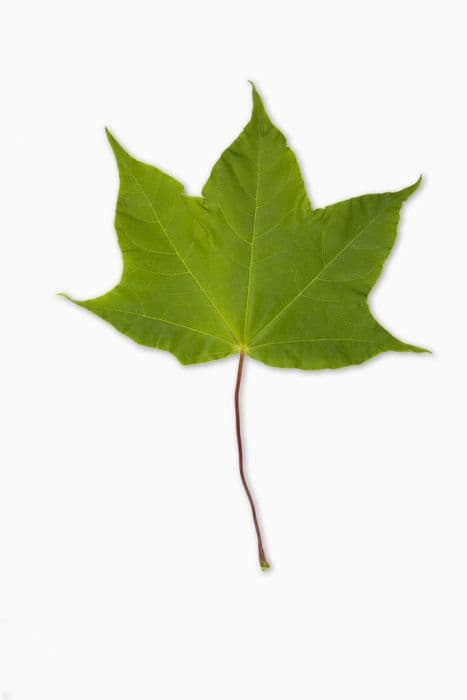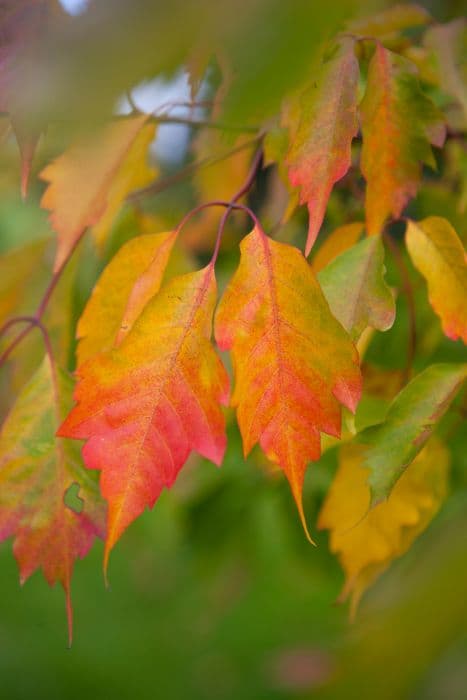Japanese Maple Acer palmatum 'Oridono-nishiki' (P/v)
ABOUT
The Japanese Maple 'Oridono-nishiki' is admired for its striking foliage, which is the standout feature of this plant. The leaves are uniquely patterned in a way that each one seems almost individually painted. They display a mix of colors ranging from green to cream, with splashes of pink that add to its ornamental appeal. During different seasons, the leaves may change hues, giving the tree a dynamic and ever-transforming appearance. The leaves themselves have a palmate shape, resembling an open hand, with several pointed lobes that spread outward. This star-like, hand-shaped foliage is a classic characteristic of the Japanese Maple. As the plant progresses through the year, its leaves transform from the vibrant spring variegation to more muted tones in the summer, culminating in a show of oranges and reds in the fall, before leaf drop. It's this seasonal change that makes 'Oridono-nishiki' a delight for any garden, as it provides a cascade of colors throughout the year. The bark of 'Oridono-nishiki' also features its own variegated appearance, with patches of gray intermingling with the green, creating a mosaic that provides visual interest even in the absence of leaves during the dormant season. Collectively, the unique coloration of its foliage and bark, along with the delicate structure of the leaves, make the Japanese Maple 'Oridono-nishiki' a specimen that can provide a focal point in a garden setting, capturing the eye with its distinctive and artistic presence.
About this plant
 Names
NamesFamily
Sapindaceae
Synonyms
Japanese Maple, Smooth Japanese Maple
Common names
Acer palmatum 'Oridono-nishiki'
 Toxicity
ToxicityTo humans
Japanese maple, the common name for Acer palmatum 'Oridono-nishiki', is generally not considered toxic to humans. There is no significant risk of poisoning from ingesting parts of this plant, and it is typically safe to have around without worry of ingestion by children or adults.
To pets
Japanese maple is not known to be toxic to pets either. It is generally considered safe for dogs, cats, and other household animals. There should be no adverse symptoms from ingestion of parts of this plant by pets.
 Characteristics
CharacteristicsLife cycle
Perennials
Foliage type
Deciduous
Color of leaves
Variegated
Height
6-8 feet (1.8-2.4 meters)
Spread
6-8 feet (1.8-2.4 meters)
Plant type
Tree
Hardiness zones
5-9
Native area
Japan
Benefits
 General Benefits
General Benefits- Aesthetic Appeal: The plant adds visual interest to gardens due to its variegated leaves that change color throughout the seasons.
- Shade Providing: It can create shaded areas in the garden, which can be beneficial for both people and underplantings.
- Habitat Support: It serves as a habitat for various species of birds and insects, contributing to biodiversity.
- Seasonal Interest: It has a striking appearance during different seasons which can enhance the seasonal beauty of a landscape.
- Size Variation: Available in various sizes, it can fit into diverse garden designs, from large landscape features to container gardening.
- Low Maintenance: Once established, it requires relatively minimal care, making it suitable for novice gardeners.
- Cultural Significance: It's often associated with Japanese gardens, bringing a sense of tranquility and traditional elegance to any setting.
- Erosion Control: The root systems can help stabilize soil and control erosion in certain landscapes.
- Privacy Screen: When planted in groups, it can act as a natural privacy screen while still being aesthetically pleasing.
- Value Addition: Mature specimens can increase property values due to their beauty and desirability in landscaping.
 Medical Properties
Medical PropertiesThis plant is not used for medical purposes.
 Air-purifying Qualities
Air-purifying QualitiesThis plant is not specifically known for air purifying qualities.
 Other Uses
Other Uses- Acer palmatum 'Oridono-nishiki' can be used in bonsai culture due to its attractive foliage and the ability to adapt well to pruning and training.
- This Japanese Maple variety can be incorporated into theme gardens, such as a Zen garden, for its aesthetic form and calming presence.
- The unique coloring of the leaves can be used in art projects, such as leaf pressing or casting, to capture the beauty of nature.
- Japanese Maple wood, being hard and dense, can be crafted into small wooden objects like handles, knobs, or buttons.
- The striking appearance of the tree through different seasons provides a stunning backdrop for photography and cinematography.
- Young stems with vibrant foliage can be used in floral arrangements as a distinctive focus point.
- In landscape design, this plant can serve as a natural screen or partition, especially varieties with dense foliage.
- Its vibrant colors can be used for educational purposes, helping to teach children about plant biology and the change of seasons.
- Fallen leaves can be gathered and used as a natural mulch, providing nutrients back to the garden as they decompose.
- The tree can act as a habitat and food source for birds and beneficial insects, promoting local biodiversity.
Interesting Facts
 Feng Shui
Feng ShuiThe Japanese Maple is not used in Feng Shui practice.
 Zodiac Sign Compitability
Zodiac Sign CompitabilityThe Japanese Maple is not used in astrology practice.
 Plant Symbolism
Plant Symbolism- Beauty and Elegance: Acer palmatum, commonly known as Japanese Maple, is revered for its stunning foliage and elegant branching structure, symbolizing natural beauty and sophistication.
- Change and Transformation: With leaves that change color through the seasons, Japanese Maple represents the ever-evolving nature of life and the beauty of embracing change.
- Peace and Serenity: The calming presence of Japanese Maple in gardens evokes a sense of tranquility, making it a symbol for peace and quiet reflection.
- Balanced Life: As the tree gracefully balances its foliage, it symbolizes the importance of living a balanced and harmonious life.
 Water
WaterJapanese Maple should be watered regularly, especially during dry spells, to keep the soil consistently moist but not waterlogged. Newly planted trees require more frequent watering, about once or twice a week, to help establish roots. Mature trees should be watered less frequently, roughly every two weeks. The amount of water depends on the size of the tree and the weather; an average recommendation would be to provide 10 to 15 gallons every two weeks during the growing season. Always adjust your watering schedule according to the rainfall and the season, reducing the amount in late fall to winter.
 Light
LightJapanese Maples prefer a location with partial shade, especially in the hotter zones, to protect their delicate leaves from scorching sun. However, they can tolerate full sun in cooler climates. An ideal spot offers morning sun and afternoon shade, ensuring the tree receives sufficient light without the intensity of midday heat.
 Temperature
TemperatureJapanese Maples are hardy and can withstand a range of temperatures; they grow best in USDA zones 5 through 8. The ideal temperature range for these trees is between 60°F and 80°F. They can survive in temperatures as low as -10°F and tolerate summer peaks up to 90°F but may need protection from extreme heat or frost.
 Pruning
PruningPrune Japanese Maples primarily to remove dead or crossing branches and to maintain their shape. The best time for pruning is during the late winter or early spring before the sap starts flowing and the new leaves develop. Prune sparingly; once a year is often enough as these trees naturally have a pleasing shape.
 Cleaning
CleaningAs needed
 Soil
SoilJapanese Maple requires well-draining soil with a pH of 5.5 to 6.5. A mix of loam, peat, and sharp sand or perlite is ideal, ensuring moisture retention and aeration.
 Repotting
RepottingJapanese Maples should be repotted every two to three years to prevent root bound conditions and encourage healthy growth.
 Humidity & Misting
Humidity & MistingJapanese Maples prefer moderate humidity levels but are adaptable to the typical outdoor humidity range in their growing zones.
 Suitable locations
Suitable locationsIndoor
Ensure bright, indirect light and keep away from dry heat sources.
Outdoor
Plant in partial shade, protect from harsh winds, and mulch well.
Hardiness zone
5-9 USDA
 Life cycle
Life cycleJapanese Maple 'Oridono-nishiki' begins its life cycle when a seed germinates, ideally in a moist, well-draining soil environment. The seedling develops into a young tree, establishing a root system and producing its first leaves which are often variegated in this cultivar. As the tree grows, it experiences a period of vegetative growth each year with new leaves and stems, showcasing its distinctive pink, white, and green foliage. The tree reaches maturity in several years, at which point it can produce flowers, followed by the development of winged samaras (seed pods) which disperse in the wind, continuing the reproductive cycle. Each year, the tree undergoes a period of dormancy during the colder months, shedding its leaves and storing energy in its roots for the following spring's growth. Throughout its lifetime, which can span over a century if conditions are ideal, Japanese Maple 'Oridono-nishiki' undergoes repeated cycles of growth, reproduction, and dormancy, providing seasonal interest with its changing foliage and structure.
 Propogation
PropogationPropogation time
Late winter-early spring
The Japanese Maple 'Oridono-nishiki' is a striking variegated cultivar that is best propagated through grafting. Grafting is most successfully performed in late winter or early spring before the tree breaks dormancy. The most popular method is known as scion grafting, where a small branch, or scion, from the 'Oridono-nishiki' is joined to the rootstock of another Japanese maple that has a vigorous root system. The scion, which is usually about 2-6 inches (5-15 centimeters) long, is cut at an angle to expose a large surface area and then carefully matched to a similarly cut surface on the rootstock. The two are bound tightly with grafting tape or a similar material to hold them securely in place while the graft union heals, a process that can take several weeks to months depending on the conditions such as temperature and humidity. Grafting not only preserves the variegated characteristics of the 'Oridono-nishiki' but also ensures the resulting tree benefits from the hardiness and vigor of the rootstock.









